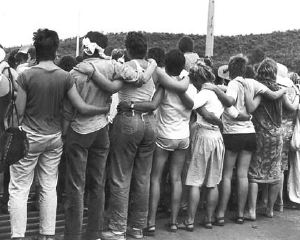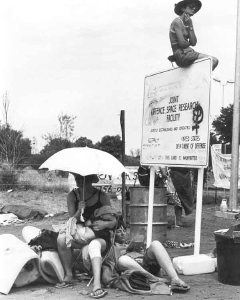
© Silva Vaughan-Jones: used with permission.

My mother - English, living on Sydney's North Shore and not at all 'out' about my sexuality - had an eighty-year old friend who came to Alice Springs on holiday. After her visit, my mother, interested because this is, after all, my home town, asked for her friend's impressions. "Oh, lovely," came the reply. "I really liked Alice Springs. You know, m'dear, there seems to be something of a sisterhood in that town."
"Something of a sisterhood" - I love that phrase to describe the visibly large, some say socially and economically powerful, community of single women and lesbians who live in the Alice. If the rest of Australia has a ten percent gay population, then 15 percent in Alice are lesbians, with a few brave gay men hanging on at the fringes.
Why women? Why Alice? Why so out in the open? It's a phenomenon worthy of an anthropological PhD, preferably written by one of the 'girls'. Times have changed since, a decade ago, an unwitting ABC reporter asked to make a doco about the lesbian community in Alice and received the rebuff: "No, don't patronise me with your heterosexual privilege." So here goes with my own theory:
Lesbians, unencumbered, at least in my generation, by kids and the needs of men pursuing careers, were always much more at liberty to go bush than their heterosexually-married sisters. And the Northern Territory has been a refuge from the constraints of corsets, stilettos and the good-girl manners of city living since the first white woman arrived one hundred-odd years ago. Women in trousers are the norm out here.
This goes some way to explaining why the sisters come but doesn't clarify how the numbers grew to be so large or tell us why Alice is preferred over Darwin or Katherine or somewhere in between. Somewhere like Tennant Creek, for instance.
Well, let's face it, Tennant is a tough miners' town, where hard yakka, hard drink and a good old-fashioned Outback brawl are all part of a day's work. It is scarcely likely to attract women wanting women. The same goes for Mt. Isa, Broken Hill or Kalgoorlie, all blokey, boozy mining towns, where belonging to a minority can bring social scorn, even raids by the drugs squad. Trust me, I speak from personal experience. So, if girls are your particular fancy, heading off to towns with more men than women is hardly guaranteed to improve your love life. If, in addition, you want an interesting job when you leave the smoke for the spectacular environment of the desert, then Alice really is the only option.
The gender-skewed demographics of the Outback are still only part of the story, however. For the sheer size of the lesbian community, we must thank our adversarial political system, the Cold War and some of our American friends. But allow me, first, a small digression.
Nearly forty years ago, at the age of six, I came from London to Australia and found the eucalypt scrubland of the east coast brown, messy and aesthetically distasteful. At 16, I went into the Outback on a school excursion, became entranced by the flatness, the distance, the dust and something that looked like an authentic Australian culture and not English wannabe copycat. Alice, with its rugged ranges, red hues and mobs of big, red roos bounding across the vast plains, stole my heart. I knew then that this was the real Australia.
In 1982, my girlfriend from Wollongong and I decided to buy a four-wheel drive and travel around Oz. It was pioneering stuff back then. Women did not own four-wheel drives in those days, at least not without a man in the picture. We got bogged and learnt how to 4WD from the boys who 'rescued' us with disparaging remarks. We learnt quickly, as those needing to prove a point invariably do. It took us a year to get from Sydney to Cairns and on the way, the closest we came to other lesbians was graffiti on the back of a toilet door in Mackay.
Desperation was a dull ache in our coupled consciousness until someone in Brisbane gave us the name of a sister living up north, the only dyke in a 1,000 square kilometres, or so it seemed. By the time we got to Cairns, we were also desperate for green weed but unfortunately our new friend was a drug-free vegetarian. She did, however, tell us about a women-only protest about to take place at the gates of an American military base near Alice Springs. A thousand women were expected and that must mean more of the sisterhood than usual. Peace, the purpose of the protest, was, I confess, an afterthought.
So, one tropically wet day in November 1983, my girlfriend and I, two hippy lesbians (though we didn't think of ourselves as hippies at the time because hippies were by definition heterosexual) found ourselves in an Innisfail house that looked like it came straight from the set of Gone With The Wind. It was a huge, white colonial mansion, owned by a couple who had made millions in Papua New Guinea. The 'missus' was a staunch member of the Women's International League for Peace and Freedom (WILPF). A passionate environmentalist, she was almost single-handedly guarding the biggest of Far North Queensland's rainforest trees from destruction. She literally watched the loggers log and complained if they cut the wrong trees. She had friends in high places and knew that money talks. She was driving to Alice and we were welcome to a lift, even though she had never met a lesbian before.
Also with us was Lemone, a Scottish witch, who said she was 65 but looked 165. She read auras and healed broken bodies and souls through the feet. Her dream was to wash the feet of Jesus in Heaven.
Lemone was born, she said, in the first town in the world to get nuclear power. Her hair had fallen out when she was 17, the river was polluted, strange children were born and nobody believed the townspeople when they tried to tell their tale. Lemone, a Quaker, travelled the world, protesting against war, nuclear power and US might. Lemone did not have an apprentice, a woman to whom she could pass on her secrets. Lemone was looking for someone. Lemone loved me, told me my aura was pink and full of love and ignored my girlfriend pretty much all the way to Alice. It was not comfortable.
And finally,
there
was Wendy, a young student of Aboriginal languages, who
practised her Pitjantjatjara
with every petrol-stop drunk she could find, or so it seemed
to me. Wendy,
a self-confessed Communist, hated hippies because, she said,
we had no
politics. I can only guess what she thought of self-styled
Christian witches.
| So
there we were,
five women, previously unknown to each other, thrown
together in the intimate
space of a Toyota troop carrier for the four-day
journey from Cairns to
Alice. I have no idea how we survived without killing
each other but we
did. And along with 1,000 other women, each with her
own journey tale,
we camped for two hot and dusty weeks in front of the
gates of the Pine
Gap Joint Defence Research Facility, as it was then
called.
We
were a thousand
women, singing, dancing, crying, laughing,
loving and battling for
world peace. The local press, recently acquired by
Rupert Murdoch, noticed
that many of the women were gay and pushed the
sophisticated view that
the protestors were Russian-paid, feral lesbians.
Although nobody much
believes the Russian-paid bit any more, many of the
'old school' in Alice
Springs remain convinced that the protesters were
feral lesbians.
|

© Silva Vaughan-Jones: used with permission. |
Which brings me back to the disproportionately large size of the lesbian community in Alice. Of course there were an awful lot of lesbians at the Pine Gap protests because, as I said before, they were free to travel. Many of the women, straight and gay, who came in 1983 were stunned by the beauty of Australia's desert heart. Many were also fearfully concerned at the plight of indigenous Australians and chose to return to Alice as doctors, lawyers and teachers.
And so, by the early 1990s, the lesbian community had become numerically large enough to ensure continual regeneration. It's what the mathematicians call a 'critical mass'.
As for it being visible to outsiders, personally I have never noticed it. Perhaps that is because it is harder to see a forest when you are one of the trees.
This story was first published at BushMag.